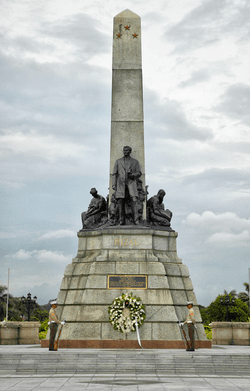Manila Army and Navy Club



The Manila Army and Navy Club founded in 1898 was the first American social club to be established in the Philippines for the exclusive use of the U.S. military personnel and civilians, and later Filipinos.[1] Since the time it was established, it was one of the center of Manila's social life. It was the site of many important events in Philippine-American relations.[2]
The Building
The building was designed by William E. Parsons[2] and has his characteristic trademark of the generous use of arches. It was built by the US Army Corps of Engineers. It was completed in April 17, 1911
In his book, McCallus described the current state of the Army and Navy Club as:[1]
a dignified white structure, nearly hidden by beautiful palms and acacia trees, and guarded by a well-carved wrought iron fence. The original was a spacious H-shaped affair (...). The club has a reputation of being among the best of its type in the world with excellent food, a superb staff, and a swimming pool. It also boasted a bowling alley, tennis and squash courts, and a huge officer's bar.
History
.jpg)
The Army and Navy Club of Manila was organized in December 1898. The first president was Col. Smith of California.[3] Notable persons who became its presidents were Adm. George Dewey, Gen. Arthur MacArthur, Jr. and his son Douglas MacArthur, and Leonard Wood.
Originally, the Club was housed in a building in Intramuros, Manila and then in April, 1911 transferred to its present site near Rizal Park, an area along the shores of Manila Bay reserved by urban planner Daniel Burnham in his plan of Manila. The club shared a lot with the Manila Elks Club, a local branch of the fraternal lodge of the Benevolent and Protective Order of Elks whose membership was open to civilians and is still operating. Together they were the center of the social life of Americans in Manila for many decades.
During the Second World War, it was used as a bomb shelter and evacuation center during attacks by the Japanese Army and it was occupied by the Japanese during the entirety of the Japanese occupation of the Philippines.
The building survived the war but its gradual decline began in the 1960s and for a time served as the city architect's office until the building showed signs of crumbling. It was then used as a manufacturing site for the city's Christmas lanterns, thereby contributing more to the building's decay until it was resurrected as the short-lived Museo de Manila. [1]
On April 26, 1991, it was declared a National Historical Landmark by the National Historical Institute.[4][2] In 2007 the then-derelict building was planned to be renovated.[5]
Life at the Club
During the American colonial period, Filipinos were not allowed in the club[1] as described by a 1922 New York Times article on a speech from Senator Bingham:[6]
Mr. Bingham's audience [during a speech in Hawaii] was all attention as he proceeded to relate how, a few weeks previously, he had been invited as guest of honor to a banquet in the Army & Navy Club of Manila. Mr. Bingham had asked whether outstanding native politicians, such as President Manuel Quezon of the Philippine Senate or Senator Sergio Osmena, independence leader, would be present; "Certainly not," snorted the Army & Navy Club of Manila, and proceeded to instruct Mr. Bingham that no Filipinos (except, of course, servants) were admitted within the doors of the Army & Navy Club of Manila.
The Club in the 1930s was described by Aslakson:[7]
The Army and Navy Club had a large veranda on the second floor on one side which had a long line of bunks side by side the length of the veranda. This was known as "drunk's row". We still had prohibition in the United States and when a transport came in there was sure to be many of the new arrivals who would imbibe too freely. Fellow officers would haul them up to "drunk's row" and let them sleep it off. In the morning fifteen to twenty officers would wake up on those bunks.The Club had a beautiful swimming pool between the club and the sea wall which on festive occasions such as New Years Eve would at times be the recipient of officers and their wives in evening clothes.
References
| Wikimedia Commons has media related to Manila Army and Navy Club. |
- 1 2 3 4 McCallus, Joseph (2010). The MacArthur Highway and Other Relics of American Empire in the Philippines. Potomac Books.
- 1 2 3 Alarcon, Norma. The Imperial Tapestry, American Colonial Architecture in the Philippines. University of Santo Tomas Publishing House. p. 79. ISBN 978-971-506-474-3.
- ↑ http://query.nytimes.com/mem/archive-free/pdf?_r=1&res=9D06E0DF1E39E433A25753C1A9649D94699ED7CF&oref=slogin
- ↑ "Resolution No. 2, s. 1991. Declaring the Army and Navy Club Building on South Boulevard, Manila a National Historical Landmark." (PDF). National Historical Commission of the Philippines. Retrieved 15 October 2014.
- ↑ Manila’s Army and Navy Club to be restored
- ↑ Bingham on Brownskins
- ↑ http://www.lib.noaa.gov/edocs/AslaksonPhilippines.html
